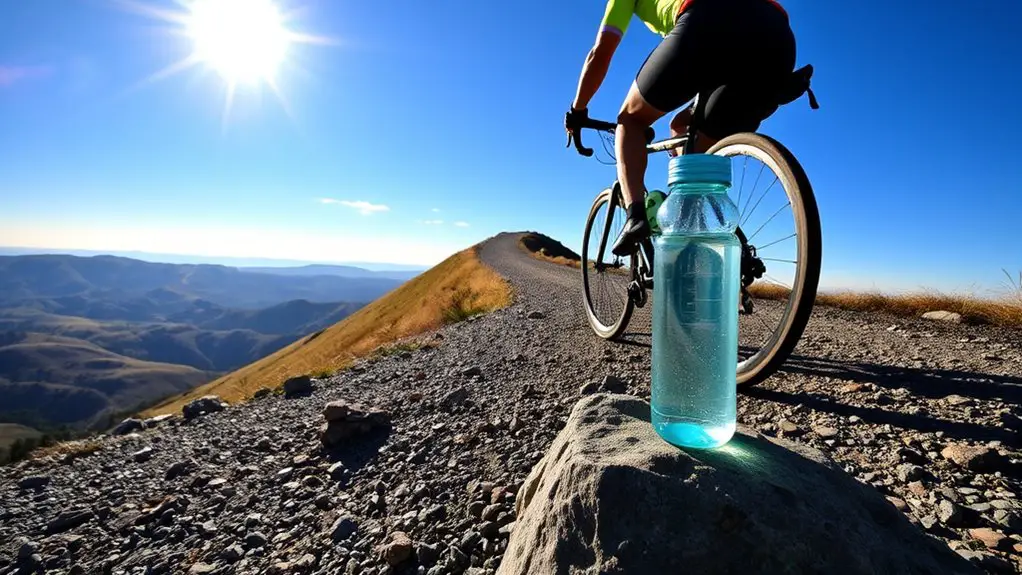To train for steep hill climbs in cycling, focus on building leg strength through exercises like squats and lunges. Incorporate hill repeats into your routine to enhance endurance and technique, while also maintaining flexibility and core stability. Don't forget nutrition—carbohydrate loading and hydration are key. Additionally, mental preparation with visualization can boost your confidence. With consistent tracking of your progress and clear goal-setting, you'll see improvement. There's more to contemplate for mastering those climbs.
Understanding the Physiology of Climbing
When you tackle steep hill climbs, it's vital to understand the physiology behind climbing. Your body relies on various energy systems to power through those challenging ascents. As you push harder, your muscles undergo adaptation, becoming more efficient at utilizing oxygen and energy sources. This increased efficiency allows you to ride longer and stronger.
During climbs, your anaerobic system kicks in for short bursts of effort, while your aerobic system becomes fundamental for sustained climbs. Balancing these systems is key to maximizing your performance. You might find that your muscles start to adapt to the specific demands of climbing; this means you'll develop greater endurance and strength over time. Additionally, improved muscle efficiency enables you to reduce fatigue and enhance your overall performance on steep gradients.
Embrace this journey of muscle adaptation, and you'll discover newfound freedom in your cycling. The more you understand your body's energy systems, the better equipped you'll be to conquer those intimidating hills with confidence.
Essential Strength Training Exercises
Strength training is essential for enhancing your climbing ability in cycling. To conquer steep hills with confidence, focus on building leg strength through resistance training. Squats and lunges are fantastic for developing the muscles that power your climbs. Don't forget your upper body; a strong back and arms help stabilize your position on the bike. Core stability is vital, so incorporate exercises like planks and Russian twists to maintain balance during tough ascents. Additionally, incorporating Olympic lifts can significantly improve your explosive strength, which is crucial for powerful climbs.
Flexibility training should also be part of your routine; it helps prevent injuries and improves your overall range of motion. Add in balance exercises to enhance your control on uneven terrain. Finally, plyometric drills can boost your power output, giving you that extra push when you need it most. By integrating these essential strength training exercises into your training regimen, you'll feel freer and more capable to tackle those challenging climbs ahead.
Developing Endurance for Long Climbs
To tackle long climbs, you'll need a solid endurance foundation built through structured training plans. Pairing this with the right nutrition and hydration strategies will help you maintain energy levels throughout your rides. Let's explore how to create an effective approach to boost your climbing stamina. Incorporating high-intensity interval training can significantly enhance your aerobic capacity, making those steep climbs feel more manageable.
Structured Training Plans
While tackling steep hill climbs can be intimidating, having a structured training plan can greatly boost your endurance and performance. By focusing on training frequency and workout duration, you can build the stamina needed for those challenging ascents.
Here's a simple plan to follow:
| Week | Training Frequency | Workout Duration |
|---|---|---|
| 1 | 3 times/week | 60 minutes |
| 2 | 4 times/week | 75 minutes |
| 3 | 4 times/week | 90 minutes |
Consistency is key! Gradually increasing your training frequency and workout duration will help you adapt to longer climbs. Embrace the freedom of the open road, and remember, every climb conquered is a victory in itself!
Nutrition and Hydration Strategies
As you prepare for those grueling hill climbs, paying attention to your nutrition and hydration is essential for building the endurance you'll need. Start by optimizing your carbohydrate intake; aim for a mix of complex and simple carbs to fuel your rides. Consuming them before and during your climbs can help maintain your energy levels.
Hydration timing also plays a vital role. Make sure you're drinking water regularly throughout the day, not just during your rides. Consider electrolyte drinks to replenish what you lose through sweat, especially on long climbs. Listen to your body; it'll tell you when you need more fuel or hydration. With the right strategies, you'll tackle those hills with confidence and freedom.
Incorporating Hill Repeats Into Your Routine
Incorporating hill repeats into your training can greatly boost your climbing ability and overall strength. You'll want to structure your workouts to maximize these benefits, balancing intensity with recovery. Let's explore how to effectively integrate hill repeats into your cycling routine.
Benefits of Hill Repeats
Hill repeats can be one of the most effective training methods for improving your climbing strength and endurance. By incorporating hill repeats into your routine, you'll experience several key hill repeat benefits that lead to noticeable performance improvements:
- Increased Strength: Building muscle power in your legs helps tackle steep climbs with ease.
- Enhanced Endurance: Repeated efforts teach your body to sustain high intensity over longer periods.
- Improved Technique: Consistently climbing hills hones your cycling form, making you more efficient.
- Mental Toughness: Conquering tough climbs boosts your confidence and resilience on the bike.
Embrace these benefits, and you'll find that tackling those steep hills feels less intimidating, giving you the freedom to explore new terrains.
Structuring Your Workouts
To effectively integrate hill repeats into your training routine, start by evaluating your current fitness level and setting specific goals. This'll help you determine how often to include these tough workouts. Aim for a mix of intensity and recovery to keep your routine fresh and engaging, enhancing your workout variety.
Consider scheduling hill repeats once a week, gradually increasing the number of intervals as you progress. After each session, use recovery techniques like stretching and foam rolling to help your muscles bounce back.
Nutrition Strategies for Climbing Performance
While you may be focused on your training regimen, don't underestimate the impact of nutrition on your climbing performance. Proper fueling strategies can make all the difference when tackling those steep hills. Here are some key aspects to take into account:
- Carbohydrate Loading: Verify you're stocked up on carbs before your rides to meet your calorie needs.
- Hydration Timing: Drink water consistently and know when to replenish electrolytes for peak performance.
- Pre Ride Snacks: Opt for easy-to-digest snacks like bananas or energy bars to fuel your ride.
- Recovery Meals: Post-ride, prioritize recovery meals rich in protein and carbs to help your muscles recover efficiently. Additionally, staying hydrated helps avoid fatigue and cramps that can hinder your performance on steep climbs.
Mental Preparation for Challenging Climbs
As you approach a steep climb, the right mindset can be just as essential as your physical preparation. Embrace the challenge ahead and let that sense of adventure fuel you. Mental visualization is a powerful tool; picture yourself conquering that hill, feeling the wind against your face as you crest the summit. Imagine the exhilaration of reaching the top, and let that vision guide you.
In those tough moments, positive affirmations can make all the difference. Remind yourself, "I'm strong," "I can do this," or "Every pedal stroke gets me closer." These affirmations will help banish doubt and keep your spirit high. Additionally, incorporating mental conditioning into your training can significantly enhance your performance during challenging climbs.
Tracking Progress and Setting Goals
Tracking your progress and setting specific goals are essential for improving your performance on steep climbs. By focusing on goal setting and progress tracking, you'll experience a sense of freedom as you conquer each challenge. Here are four steps to keep you on track:
Tracking progress and setting goals are key to mastering steep climbs, giving you the freedom to conquer challenges with confidence.
- Define Your Goals: Set clear, achievable targets, like climbing a specific hill in a certain time.
- Keep a Training Log: Document your rides, distances, and times to see how you improve over time.
- Review Regularly: Analyze your log weekly to identify trends and areas for growth.
- Adjust as Needed: If you're not meeting your goals, tweak your plan—this isn't set in stone!
Embracing these practices will not only help you gauge your growth but also fuel your passion for cycling. Stay committed, and watch yourself soar up those hills!
Frequently Asked Questions
What Cycling Gear Is Best for Steep Hill Climbs?
When you're tackling steep hill climbs, your gear choice is essential. You'll want lightweight climbing shoes that provide good grip and support, helping you maintain your balance. Don't forget about gear ratios; a compact crankset can make a significant difference in your climbing efficiency. With the right setup, you can focus on the freedom of the ride, enjoying the challenge without being weighed down by heavy equipment. Embrace the climb!
How Do I Prevent Injuries While Training for Climbs?
To prevent injuries while training, you'll want to focus on injury prevention from the start. Make sure you're incorporating effective warm-up techniques before every ride. This could include dynamic stretches or light cycling to get your muscles ready. Also, listen to your body; if something feels off, take a break. Gradually increase your intensity and distance to avoid overdoing it. Enjoy the ride, but keep safety as your priority!
What Is the Ideal Bike Setup for Climbing?
When it comes to the ideal bike setup for climbing, you'll want to focus on climbing gears and bike fit. A compact crankset paired with an adequate gear range gives you the freedom to tackle steep inclines without burning out. Make certain your bike fit is dialed in; a comfortable position will help you maintain power and efficiency. With the right setup, you'll find joy in each ascent, conquering hills like never before!
How Often Should I Train for Hill Climbs Each Week?
When it comes to your hill training frequency, aim for at least two to three sessions a week. This'll help build strength and stamina for those climbs. Consider incorporating varied terrains in your climb preparation schedule; it keeps things fresh and fun! Remember, consistency is key, but don't forget to listen to your body. Enjoy the freedom of the ride while challenging yourself to conquer those steep hills!
Can I Train for Climbs Indoors Effectively?
Absolutely, you can train for climbs indoors effectively! With indoor cycling and virtual training programs, you've got the freedom to simulate steep hills and adjust resistance. These tools let you focus on building strength and endurance without the weather holding you back. Plus, you can tailor your workouts to fit your schedule, making it easier to stay consistent. So, hop on that bike and start climbing, no matter where you are!




